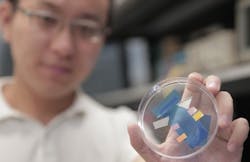Thinner photodetector could increase performance without adding bulk
Smaller is often better for many photodetector applications, but two major challenges have stood in the way of making smaller thin-film semiconductor detectors. First, shrinking the size of conventionally used amorphous thin-film materials also reduces their quality. And second, when ultrathin materials become too thin, they become almost transparent and thus lose some ability to gather light.
Now, in a nanoscale photodetector that combines a new fabrication method and light-trapping structures, a team of engineers from the University of Wisconsin–Madison and the University at Buffalo (NY) has overcome both of those obstacles.1
The device consists of nanocavities sandwiched between a top layer of ultrathin single-crystal germanium and a reflecting layer of silver. The nanocavities recycle photons to increase their absorption in the germanium thin film.
Most germanium thin films begin as germanium in its amorphous form, which means its quality isn't sufficient for increasingly small optoelectronics applications. However, one of the researchers, Zhenqiang Ma, developed a new membrane-transfer technology that allows him to easily integrate single-crystalline semiconducting materials onto a substrate.
The result is a very thin, yet very effective, light-absorbing photodetector. While the researchers demonstrated their advance using a germanium semiconductor, they also can apply their method to other semiconductors.
"And importantly, by tuning the nanocavity, we can control what wavelength we actually absorb," says Qiaoqiang Gan, another researcher.
Source: http://news.wisc.edu/powerful-new-photodetector-can-enable-optoelectronics-advances/
REFERENCE:
1. Zhenyang Xia et al., Science Advances (2017); doi: 10.1126/sciadv.1602783

John Wallace | Senior Technical Editor (1998-2022)
John Wallace was with Laser Focus World for nearly 25 years, retiring in late June 2022. He obtained a bachelor's degree in mechanical engineering and physics at Rutgers University and a master's in optical engineering at the University of Rochester. Before becoming an editor, John worked as an engineer at RCA, Exxon, Eastman Kodak, and GCA Corporation.
